
Photo Credit: Kyle Brooks
By Kyle Brooks ’17
Wildlife and Conservation Biology major
I want to talk about snakes.
As one of the two wildlife interns for Wayne National Forest, I’ve seen many a scaly serpent this summer. And I love it. I’m a huge fan of snakes, and I regularly go out of my way to search for them. But sadly, these legless reptilians are disliked and oftentimes vehemently feared by many others. Much of this fear comes from misunderstandings and misconceptions about snakes. For example, many people that I’ve talked to seem to view snakes as vicious creatures which would go out of their way to attack humans. This couldn’t be further from the truth. In fact, the average snake wants nothing to do with humans. Humans are big and scary, and a snake will either flee from the area or sit completely still and wait for the threat to pass if a human comes near.
So with this post, I want to talk about some of the most common species of snakes in Ohio, and hopefully dispel some myths and misunderstandings along the way. All of the snakes I will talk about in this post are species that Devon Cottrill (the other wildlife intern) and I came across this summer while out surveying in Wayne National Forest. So let’s jump right in, shall we?
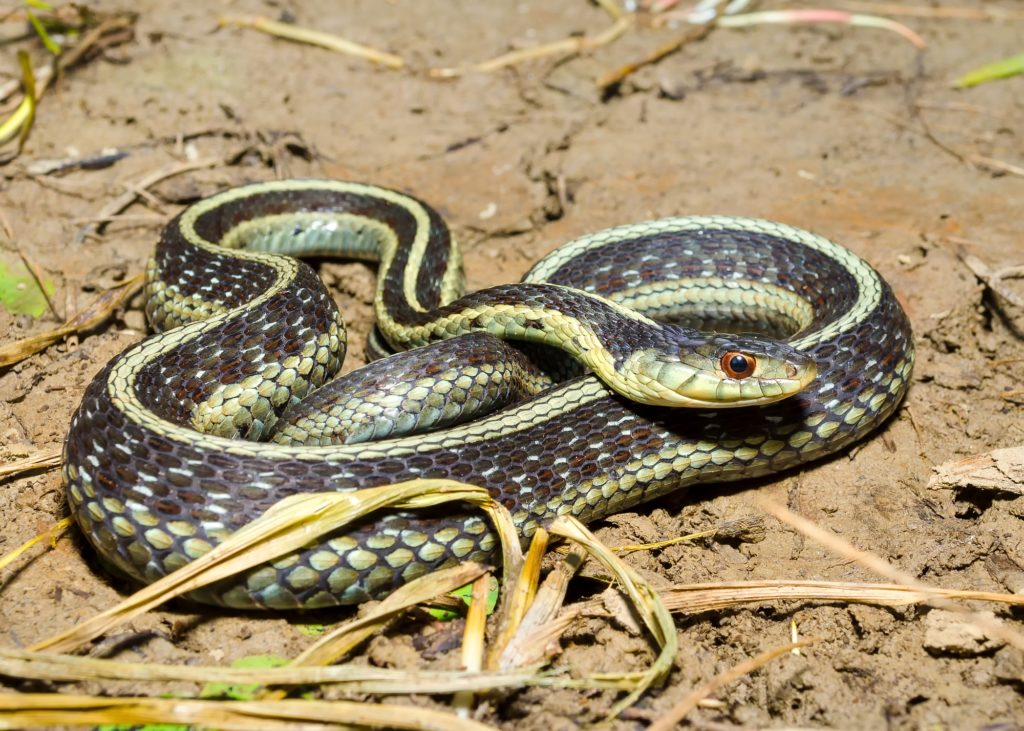
Photo Credit: Wayne National Forest – Ohio University Wildlife Intern Kyle Brooks
First up is one of—if not the most—common snake species here in Ohio, the Eastern Gartersnake (Thamnophis sirtalis sirtalis). You might know this snake by other names, such as the “garden snake,” “gardener snake,” or some other word that sounds close to “garter.” The real common name for this species is “Gartersnake,” as the people who originally named this species in the early 1700’s thought the stripes down the sides looked similar to the stripes on the garters that the men were wearing. There are actually 5 species of gartersnakes in Ohio, but only the Eastern Gartersnake is widespread throughout the state and common. The other gartersnake species in the state are rarer and not that commonly encountered.
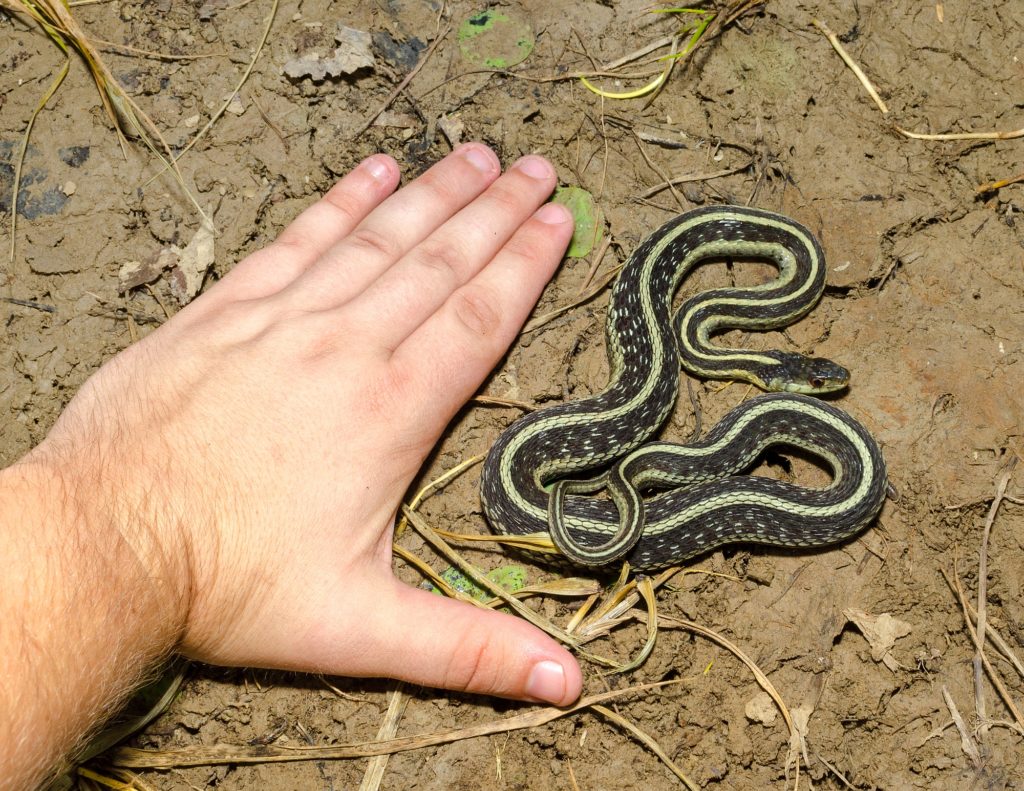
My hand for scale. Photo Credit: Wayne National Forest – Ohio University Wildlife Intern Kyle Brooks
Eastern Gartersnakes tend to hang out around creeks and other moist places, where they feed primarily on worms and other invertebrates. Occasionally a bigger Gartersnake might be able to take down a mouse or baby bird. Most Eastern Gartersnakes are relatively small, especially the males. The females will get bigger, like the individual pictured above. This Eastern Gartersnake is a normal-sized adult female. Like nearly all the other snakes in Ohio, the Eastern Gartersnake is non-venomous and completely harmless. Like the vast majority of snakes, the Eastern Gartersnake will only try to bite you if you pick them up or you try to mess with them. The easiest solution to avoid being bit by any snake? Leave the snake alone. A snake never wants to bite you, and biting is a last line of defense. Snakes will really only bite if they feel their life is being threatened. As long as you give them enough space and let them do their own thing, the Eastern Gartersnake—as well as every other snake in Ohio—will not try to bite you.
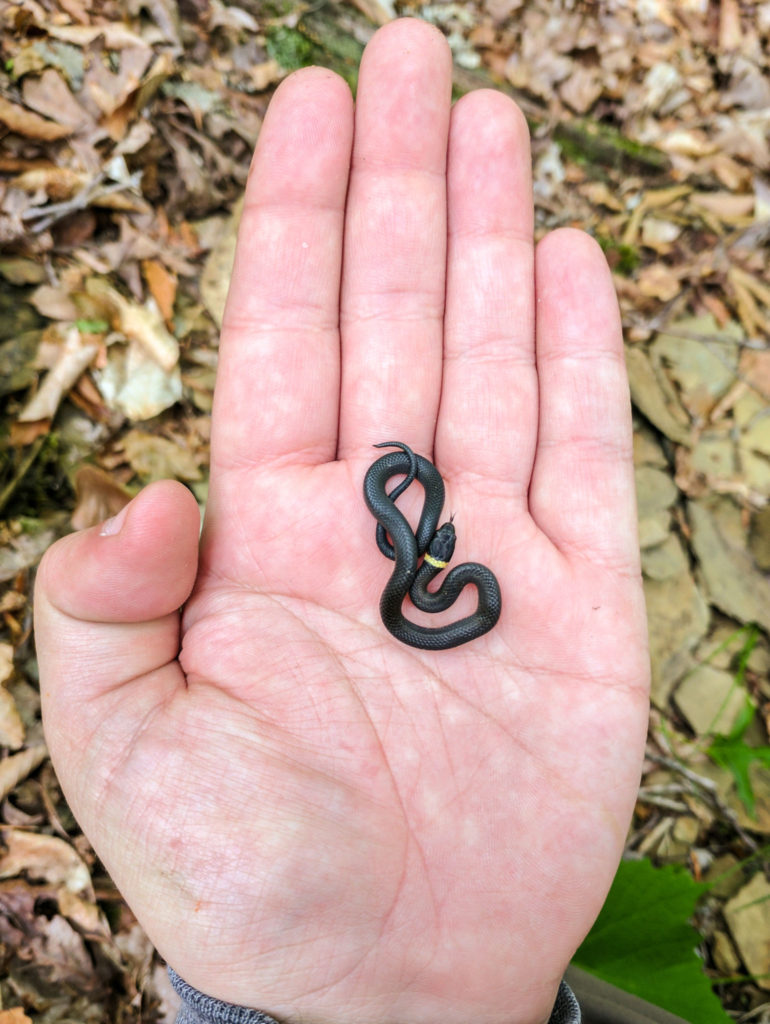
Photo Credit: Wayne National Forest – Ohio University Wildlife Intern Kyle Brooks
Another extremely common snake in this part of Ohio is the Ring-Necked Snake (Diadophis punctatus). Unlike the Eastern Gartersnake, which can be found all throughout Ohio, the Ring-Necked Snake can only be found in the southern and eastern portions of the state, along with a few areas along the shoreline of Lake Erie. Ring-Necked Snakes are tiny snakes, with most individuals being under a foot long. The Ring-Necked Snake above is even small by Ring-Necked standards, and is probably only around a year old or so. As the name implies, the characteristic feature of a Ring-Necked Snake is the yellow ring around the neck.
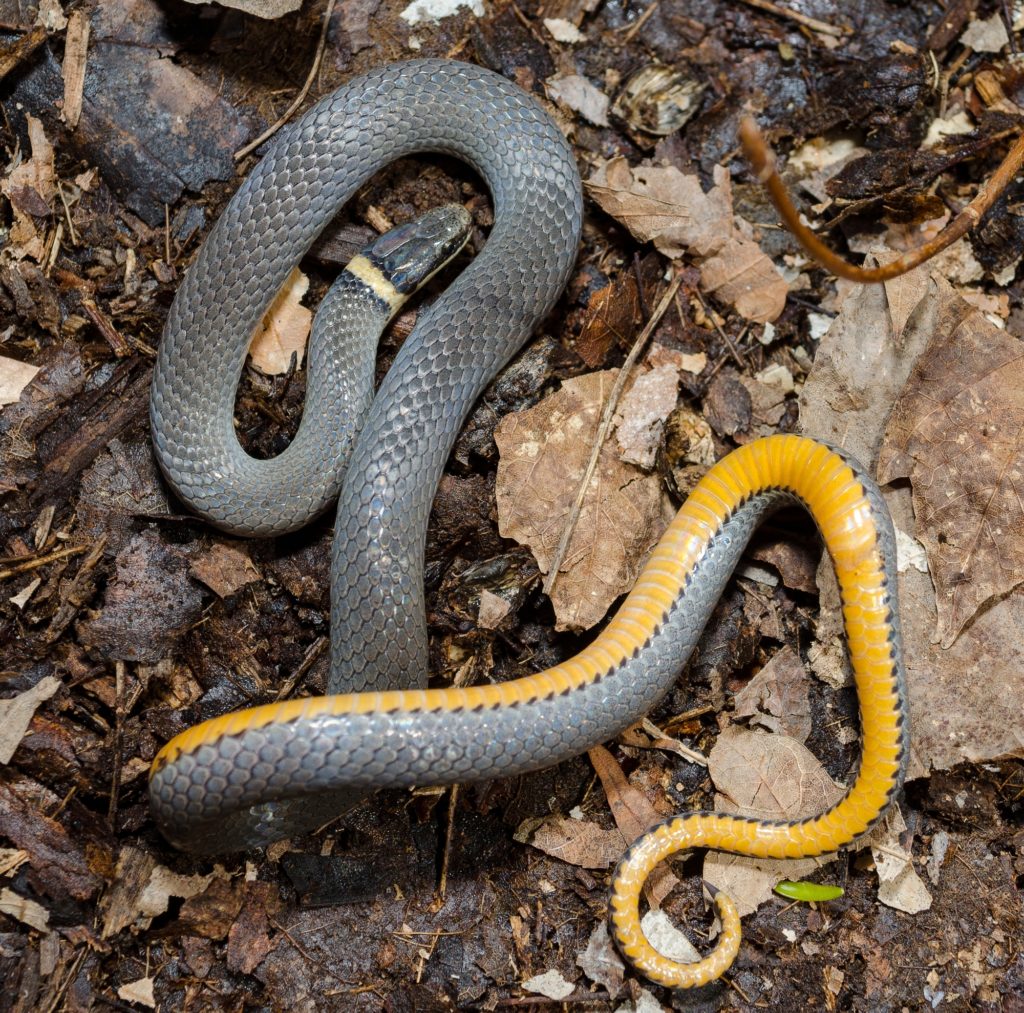
Ring-Necked Snake from northern Ohio. Photo Credit: Kyle Brooks
If you’re lucky, you might be able to see the underside of a Ring-Necked Snake, which is a stunning and beautiful yellow or orange color (it depends on the individual). Although Ring-Necked Snakes live in the deciduous forests of southern and eastern Ohio, and although they can be extremely common in those forests, they are rarely seen by people. The Ring-Necked Snake is nocturnal and spends the daylight hours hiding under rocks and logs. When night comes, the Ring-Necked Snake will venture out into the leaf-litter in search of its favorite food—forest dwelling salamanders. Like the Eastern Gartersnake, the Ring-Necked Snake is harmless and non-venomous.
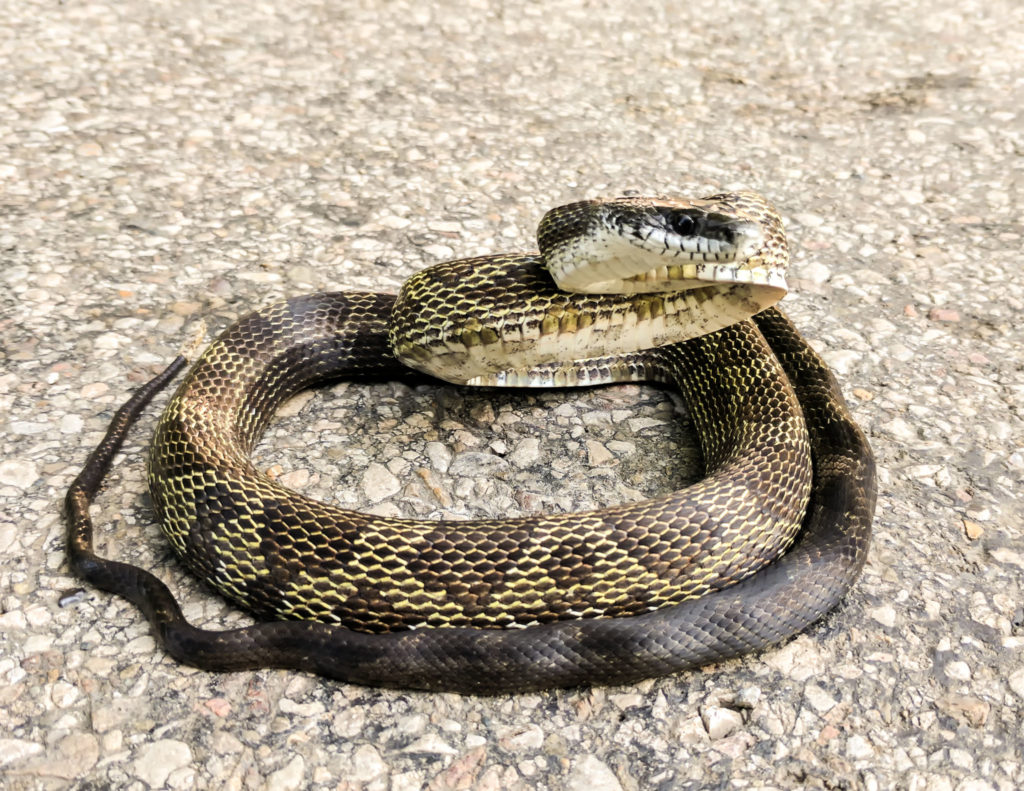
Photo Credit: Wayne National Forest – Ohio University Wildlife Intern Kyle Brooks
This next snake is actually one that is often seen, especially around farms, sheds, and the edges of forests. This is the Gray Ratsnake (Pantherophis spiloides). You might know this species by its old name, the Black Ratsnake. I won’t get into the details here, but the taxonomic classification of the “ratsnake” has been changing quickly and dramatically over the past decade and a half, and this includes both the common and scientific names changing. My use of “Gray Ratsnake” and “Pantherophis spiloides” is based on the taxonomy followed by the Society for the Study of Amphibians and Reptiles. If you are interested in ratsnake taxonomy, and want to learn more about the topic, feel free to check out the following sources: 1, 2, 3.
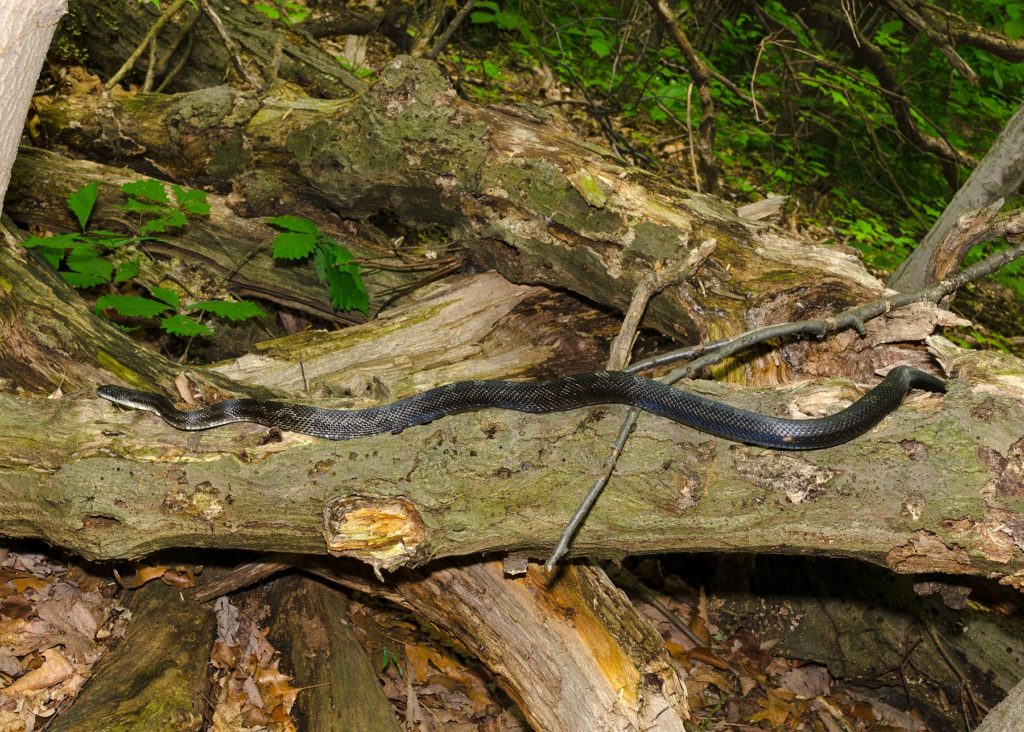
A photo of a Gray Ratsnake patrolling a fallen tree for Chipmunks or other rodents.
Photo Credit: Kyle Brooks
Sciencey-mumbo-jumbo aside, the Gray Ratsnake can be found throughout most of Ohio. This is the longest snake species in Ohio, with many adults being between 4-6 feet long, and a few extreme examples pushing 8 feet. Despite their large size, the Gray Ratsnake is a harmless, non-venomous species. Their docile nature makes them a choice “outreach species” in many Ohio nature centers. There’s another large and mostly-black snake in Ohio called the Racer (Coluber constrictor), but there’s two easy ways to tell the species apart. Racers are jet black as adults, with no other pattern. Gray Ratsnakes, on the other hand, are mostly black, but nearly always have a faint checkerboard pattern on them as well, as you can see in the photo above. The best way to tell the two species apart, however, requires close inspection of the scales. Gray Ratsnakes have “keeled scales,” which means that there’s a tiny ridge running down the middle of each scale. Racers, on the other hand, have completely smooth scales. If you live out in a rural area, a Gray Ratsnake is an extremely beneficial species to have hanging around your property. As their name implies, the Gray Ratsnake is fond of feeding on rodents. Have a mouse problem? A Gray Ratsnake will help!
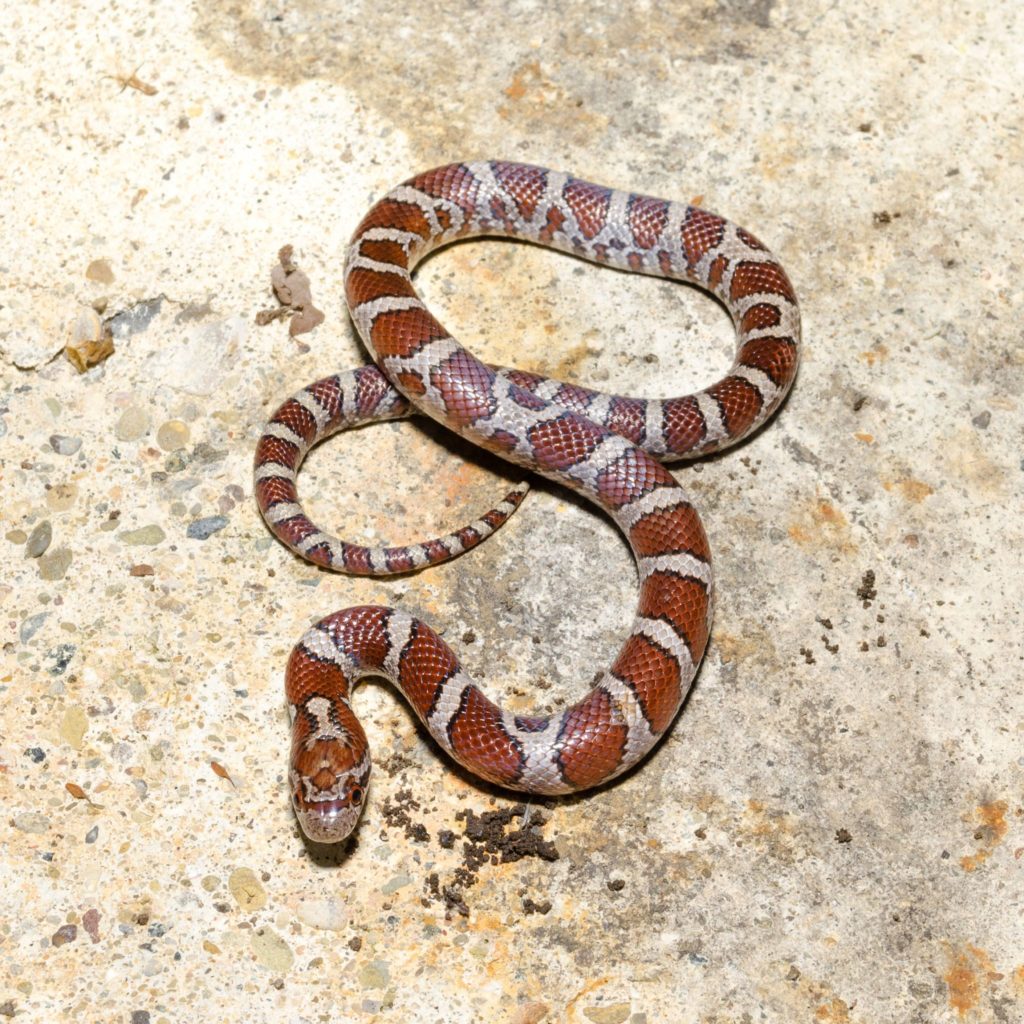
Photo Credit: Wayne National Forest – Ohio University Wildlife Intern Kyle Brooks
Next up is another very common species, but one that is very commonly misidentified. Meet the Eastern Milksnake (Lampropeltis triangulum). Like the Ring-Necked Snake, the Eastern Milksnake might be common, but isn’t seen by many. This is another nocturnal species which spends most of the daylight hours hiding under rocks, logs, and other such objects. Come night, the Milksnake will venture out in search of rodents, insects, and other small creatures to eat. The non-venomous Eastern Milksnake will many times be misidentified as a Copperhead. Although the two are somewhat superficially similar at first glance, there are a few easy ways to tell the two species apart. First, the Milksnake has a roundish head with circular pupils, while the Copperhead has a triangular head with vertical pupils. Second, the Milksnake has circular splotches or patches of red or brown, while the Copperhead has dark brown patches reminiscent of the shape of a Hershey Kiss.

Photo Credit: Wayne National Forest – Ohio University Wildlife Intern Kyle Brooks
Let’s move on to another common snake of Ohio, and one that is also very commonly misidentified: the Northern Watersnake (Nerodia sipedon). As the name implies, the Northern Watersnake is a denizen of aquatic environments, from creeks and rivers to ponds and lakes. In Ohio, this species is commonly misidentified as a Cottonmouth (also known as a Water Moccasin); however, there are no Cottonmouths in Ohio, at all. The range of the Cottonmouth does not extend up into Ohio, and the closest population to Ohio is in southwestern Indiana. The Northern Watersnake is a non-venomous species of snake. It’s also extremely wary, and will slip into the water to escape anyone who comes near. As you might imagine, the Northern Watersnake tends to feed on aquatic prey items, such as fish, frogs, crayfish, and other such creatures.
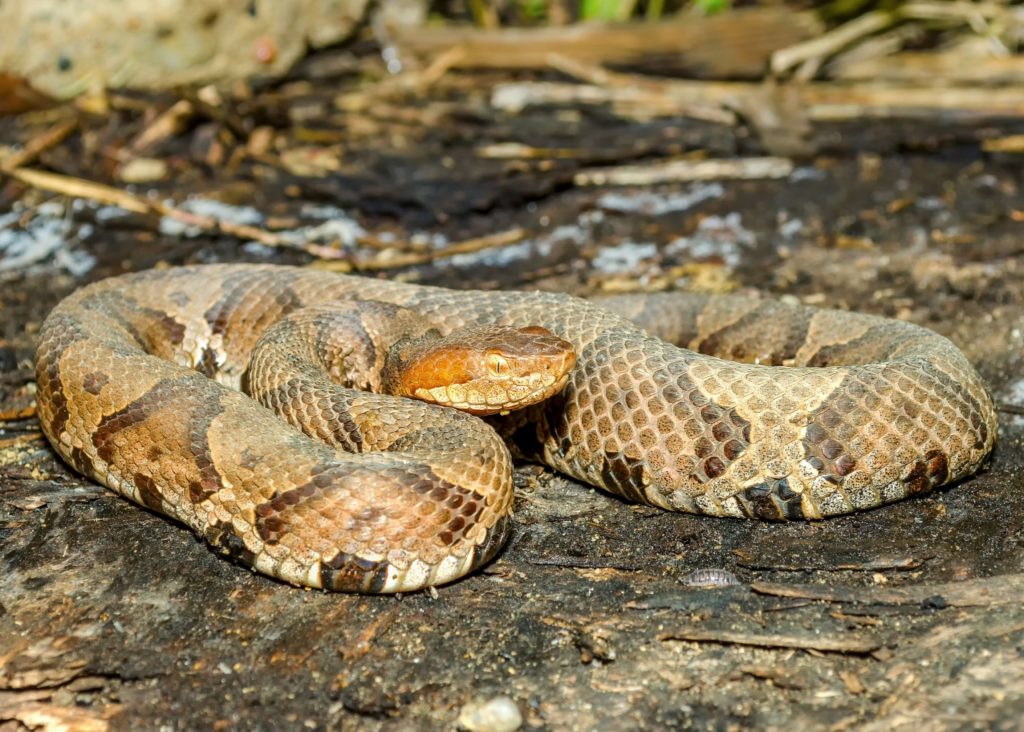
Photo Credit: Wayne National Forest – Ohio University Wildlife Intern Kyle Brooks
And what better way to end this post than with the Copperhead? The Copperhead (Agkistrodon contortrix) is one of the 3 venomous snake species in Ohio, with the other two being the Timber Rattlesnake and the Eastern Massassauga Rattlesnake. Both the Timber Rattlesnake and the Eastern Massassauga Rattlesnake are exceedingly rare in Ohio, making the Copperhead the most common of the venomous snakes in Ohio. The Copperhead can only be found in southern and southeastern Ohio (To see a map of the Ohio counties the Copperhead has been documented in, check out this link).
I’ve lived in Ohio all my life, and I’ve seen many a person misidentify pretty much any snake you can think of as a Copperhead. So how do you accurately identify a Copperhead? The best way is to take several features into account. Copperheads have a triangular head with vertical pupils, a heat pit, and the entire head will have an orange tint. Copperheads also have “Hershey kiss” shapes down their sides as well, which you can see above. These triangular brown patches on the sides will oftentimes meet on the top of the back, forming a narrow “bridge” between the two. Here’s a visualization of this pattern: Wide on sides, narrow on back.
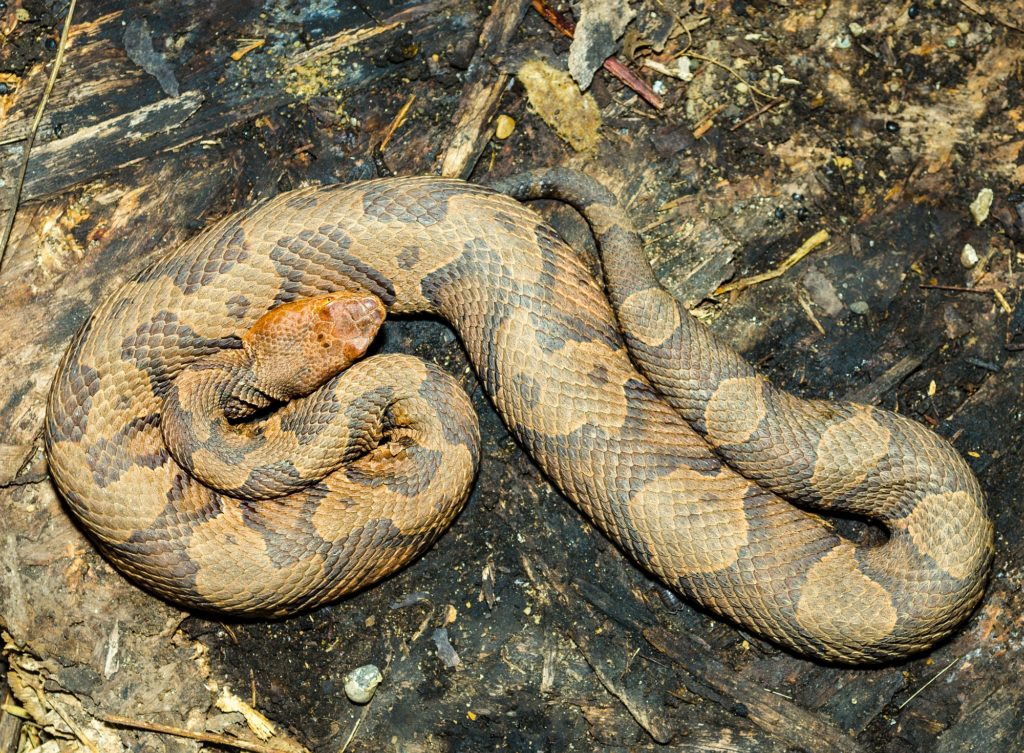
A top-down view of a Copperhead from our Wayne National Forest surveys, showing the namesake copper-colored head. Photo Credit: Wayne National Forest – Ohio University Wildlife Intern Kyle Brooks
So let’s talk about venomous snakes for a minute, and bring some facts into a discussion that’s normally dominated by fear and falsities. As I mentioned earlier, the Copperhead is venomous (not poisonous. There’s a difference between the two: an animal is venomous if it injects a toxin into your body; an animal is poisonous if it has toxins inside its body which only take effect if you eat the animal.) As with any venomous snake, one should exercise extreme caution if you find one. Give the snake space, and leave it alone. I cannot stress that point enough. In a given year, around 7,000 to 8,000 people in the United States are bit by a venomous snake of some sort, but only 4 or 5 of those bites prove fatal. You’re more likely to be bit and killed by a domestic dog than a snake. In fact, you’re even more likely to die from a lightning strike than a venomous snake bite. To put it simply, the danger of venomous snakes is highly, highly overplayed in the United States.
And here’s the kicker: The vast majority of venomous snake bites are a result of someone harassing a venomous snake, such as picking one up or trying to kill one. What is the best way to lower your chances of being bitten by a venomous snake? Leave the snake alone. It’s that simple.
Snakes are an extremely important and integral component in the ecosystems found throughout Ohio. Whenever I come across a snake, it makes my entire day; I just love these legless reptiles, with all of their incredible variation in colors, behavior, and natural histories. However, I also realize that this interest and appreciation of snakes isn’t shared by most people. I hope that this post has maybe changed that perception a bit in those of you who do not like or appreciate snakes. I hope that this post has maybe cleared up a few misconceptions that you might have had as well.
If you have any questions about snakes in Ohio, or any of the species that I talked about in this post, ask away in the comment section! I will be watching this post for the next several weeks and will answer any questions which might come up. Thanks so much for reading!
– – –
Kyle Brooks is a recent graduate of Ohio University, where he received a bachelor of science degree in wildlife and conservation biology. To read more topics on Ohio nature, visit his blog.



















3 Comments